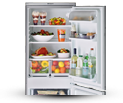It may sound strange but sometimes even frost-free appliances can need defrosting. This will become clear if first we explain "what is frost free?".

All fridge and freezers will produce icing but on frost-free this icing is on an evaporator (a type of radiator) which is behind an insulated panel usually at the back or top of the cavity.
This evaporator is cooled by gasses as they are pumped through the appliance and air is blown by a fan past the cold evaporator then around the freezer.
As soon as air passes this radiator any moisture will stick to it the same way as moisture from a room will condense on a cold window in winter. After a period of time the build up of ice would prevent the air from passing this evaporator causing the freezer to defrost so it is important for the ice to be cleared.
In a working frost-free freezer this is achieved by the timer circuit turning off the compressor (after 16 hour of running typically) and turning on a heater attached to the evaporator to melt and clear the ice. As soon as the machine recognises the ice has cleared (by seeing the warmth of the evaporator), then the compressor starts again and the cycle repeats.
The water generated by the melting ice drains through to the back of the appliance where heat from the compressor will evaporate the water away.
On occasions the ice may not completely clear and this can prevent the air circulation, as a first check a full defrost may correct this problem but if it continually reoccurs then it may be due to a fault.
To Defrost a Frost Free Freezer or Fridge Freezer:
As previously described because any ice is likely to be behind an insulated panel it is likely to require some time to clear. Professionally engineers recommend you remove all food and containers in the freezer and leave it switched off with the door open for a minimum of 36 to 48 hours to ensure all ice has had chance to defrost.
This assumes that the ambient temperature is 50 Fahrenheit - 10 centigrade or warmer, if it is colder then defrosting your freezer will take longer.
You may be able to speed up the defrosting process by using a bowl of warm water and closing the door or a steamer, but avoid using heat guns as they can easily damage the lining of the cavity.
If you have a non frost-free fridge-freezer, find out the best way to defrost it by reading our How to Defrost a Fridge Freezer article.
Get the Part: View our range of Defrost element or heater and Fridge and Freezer spares
* All information provided is a guide only. BuySpares accepts no liability for any problems occurred while attempting any advice shown. If in any doubt contact a qualified repair service.









